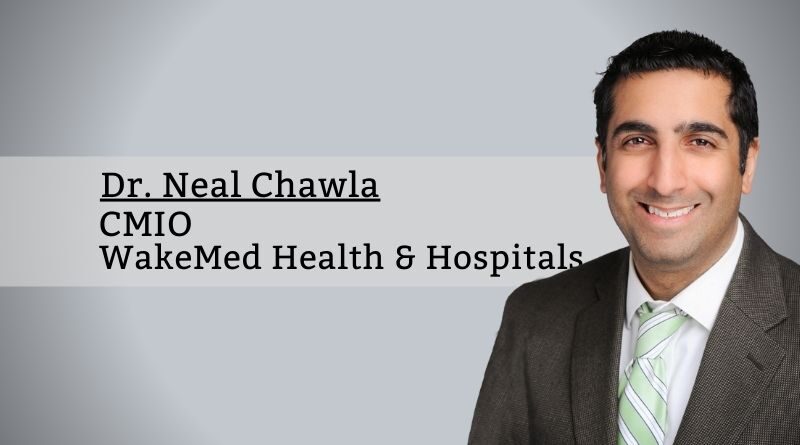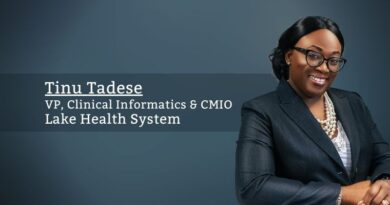Digital Transformation – We put in an EHR and stabilized it, what now?
By Dr. Neal Chawla, CMIO, WakeMed Health & Hospitals
A common thread among health systems and physician practices, particularly over the last 10 years, was the introduction and adoption of electronic health records. In most cases, it took a year or two to implement the system, plus another three to four years to truly stabilize it. Now, many are trying to optimize their investment in EHR technology.
Wait – that’s it? Is this really why we installed EHRs? To get a clunky system and spend years trying to optimize it? How is that efficient? Maybe we shouldn’t have bought these things.
We went into EHRs with visions of automation and efficiency. What we’ve learned over the past few years is that we are not getting more efficient, at least not easily. If anything, we are spending more time with the EHRs and less time with our patients. Maybe we had it wrong.
I’ll be first to admit that I had it wrong. An EHR did not make us faster and more efficient. Add on the burnout factors that an EHR platform allows – more administrative responsibilities, less control, feelings of helplessness – and it easily morphs into an overwhelming data system.
So what’s the right path?
I’ll argue for Digital (including Clinical) Transformation. While our EHRs can make us a bit more efficient if we put in the time and effort, the bigger opportunity is for EHRs to make us better, not necessarily faster.
If you haven’t yet made EHR a team sport, you’re doing it wrong. When clinical groups function more like independent contractors, where everyone practices according to how they want to, the EHR won’t work as well. However, when clinicians begin to work as a unified group – building consensus to best practices, pathways, protocols, and standards – we can start to pull value from our EHRs. There are three main ways we can capture value here: efficiency, decreased unnecessary variation, and better data to drive outcomes.
When individuals begin to function as groups, we can better configure EHRs for these groups. It’s only then we can hardwire pathways and standardize order sets and have an efficient EHR system built on best practices – not an arsenal of clinicians’ personal favorites. Not only are the standards easier to order once we hardwire them in, it is also easier for our multi-disciplinary colleagues to expect consistency instead of trying to learn everyone’s different personal preferences.
This ties into the next piece of value that EHRs can bring – decreased unnecessary variation. This is not a recommendation for using EHRs to drive ‘cookbook medicine’; medicine will never be that simple. What we should do is standardize what can be standardized by evidence and expert consensus. This will streamline our workflows, reduce cognitive load, endorse more equitable standards across populations, and ultimately improve the quality of care by setting a foundation that can be improved upon over time. Of course, there will still be ‘necessary’ variations – much of what we do does not have robust evidence, and patients often have their own personal choices for how they want to be treated. But we should reduce variation by standardizing best-practices wherever possible.
To achieve Digital (Clinical) Transformation, we need to optimize our EHR for best practices and good data collection, and we need our clinical and operational leaders to understand and utilize the data to drive standards and pathways.
Third, and arguably most important, is data. Many of us assumed that by implementing electronic health records, we would have easy access to great data. Given multiple workflows, non-standard work, and GIGO (garbage in garbage out – a concept we are all becoming fluent in), we have learned that simply putting an EHR in place does not instantly translate into good data. For many who have implemented EHRs, we merely digitized paper. It’s a good start to the journey, but not an end.
Before talking about how to get to good data, we should make sure to understand ‘the why.’ Simply put, good data allows insight into clinical and business intelligence. Upfront, you can begin to gain situational and global awareness into your clinical operation. As you mature with people, processes, and technology, you can move into using data for improvement. A key concept here is Clinical Transformation, which I’ll define as ‘leveraging data to deliberately and measurably improve patient outcomes.’ While you can continue maturing into Population Health and Predictive Analytics, you will need to begin upstream in your approach toward good data collection, or ‘data in.’
I want to drive this point home – a critical piece to improve ‘data in’ is working together. When clinical teams treat the EHR as a team sport, it becomes easier to set up your EHR for better data collection. Why? More items can be discrete on the upstream data collection end. Additionally, when we decrease our unnecessary care variation, our data quality improves, and we are able to better assess if we are delivering the appropriate care based on agreed consensus and evidence in our pathways and protocols.
While these changes will allow the production of good data, a new but good problem can emerge: are you operationally ready to leverage the data and drive change?
We want to produce good data, but pretty graphs alone don’t make us better. We need leaders to use the data to drive change. And these leaders need to have enough data literacy to understand what the data is telling us before they can drive change.
To achieve Digital (Clinical) Transformation, we need to optimize our EHR for best practices and good data collection, and we need our clinical and operational leaders to understand and utilize the data to drive standards and pathways. It may have taken a while to figure it out, but this is how we should think about our investments in implementing EHRs.
Done well, this is how we will continue to both deliberately and measurably improve patient outcomes. This is how EHRs can be leveraged to fulfill our mission in healthcare.



